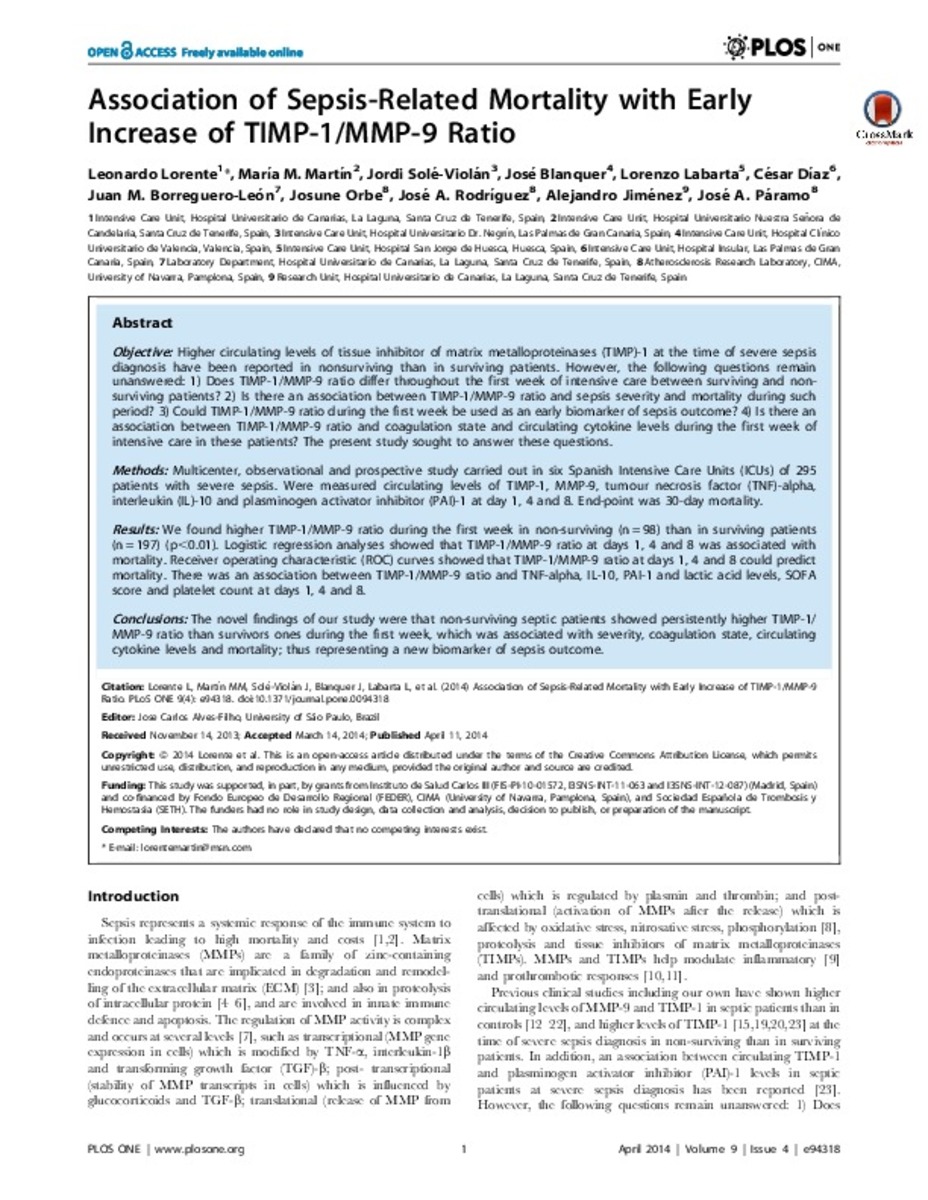Full metadata record
| DC Field | Value | Language |
|---|---|---|
| dc.creator | Lorente, L. (Leonardo) | - |
| dc.creator | Martin, M.M. (María M.) | - |
| dc.creator | Sole-Violan, J. (Jordi) | - |
| dc.creator | Blanquer, J. (José) | - |
| dc.creator | Labarta, L. (Lorenzo) | - |
| dc.creator | Díaz, C. (César) | - |
| dc.creator | Borreguero-Leon, J.M. (Juan María) | - |
| dc.creator | Orbe, J. (Josune) | - |
| dc.creator | Rodriguez, J.A. (José Antonio) | - |
| dc.creator | Jimenez, A. (Alejandro) | - |
| dc.creator | Paramo, J.A. (José Antonio) | - |
| dc.date.accessioned | 2014-09-10T10:23:07Z | - |
| dc.date.available | 2014-09-10T10:23:07Z | - |
| dc.date.issued | 2014-04-11 | - |
| dc.identifier.citation | Lorente L, Martín MM, Solé-Violán J, Blanquer J, Labarta L, Díaz C, et al. Association of sepsis-related mortality with early increase of TIMP-1/MMP-9 ratio. PLoS One. 2014 Apr 11;9(4):e94318. | es_ES |
| dc.identifier.issn | 1932-6203 | - |
| dc.identifier.uri | https://hdl.handle.net/10171/36511 | - |
| dc.description.abstract | OBJECTIVE: Higher circulating levels of tissue inhibitor of matrix metalloproteinases (TIMP)-1 at the time of severe sepsis diagnosis have been reported in nonsurviving than in surviving patients. However, the following questions remain unanswered: 1) Does TIMP-1/MMP-9 ratio differ throughout the first week of intensive care between surviving and non-surviving patients? 2) Is there an association between TIMP-1/MMP-9 ratio and sepsis severity and mortality during such period? 3) Could TIMP-1/MMP-9 ratio during the first week be used as an early biomarker of sepsis outcome? 4) Is there an association between TIMP-1/MMP-9 ratio and coagulation state and circulating cytokine levels during the first week of intensive care in these patients? The present study sought to answer these questions. METHODS: Multicenter, observational and prospective study carried out in six Spanish Intensive Care Units (ICUs) of 295 patients with severe sepsis. Were measured circulating levels of TIMP-1, MMP-9, tumour necrosis factor (TNF)-alpha, interleukin (IL)-10 and plasminogen activator inhibitor (PAI)-1 at day 1, 4 and 8. End-point was 30-day mortality. RESULTS: We found higher TIMP-1/MMP-9 ratio during the first week in non-surviving (n = 98) than in surviving patients (n = 197) (p<0.01). Logistic regression analyses showed that TIMP-1/MMP-9 ratio at days 1, 4 and 8 was associated with mortality. Receiver operating characteristic (ROC) curves showed that TIMP-1/MMP-9 ratio at days 1, 4 and 8 could predict mortality. There was an association between TIMP-1/MMP-9 ratio and TNF-alpha, IL-10, PAI-1 and lactic acid levels, SOFA score and platelet count at days 1, 4 and 8. CONCLUSIONS: The novel findings of our study were that non-surviving septic patients showed persistently higher TIMP-1/MMP-9 ratio than survivors ones during the first week, which was associated with severity, coagulation state, circulating cytokine levels and mortality; thus representing a new biomarker of sepsis outcome. | es_ES |
| dc.language.iso | eng | es_ES |
| dc.publisher | Public Library of Science | es_ES |
| dc.rights | info:eu-repo/semantics/openAccess | es_ES |
| dc.subject | Tissue inhibitor of matrix metalloproteinases (TIMP)-1 | es_ES |
| dc.subject | Sepsis | es_ES |
| dc.subject | MMP-9 | es_ES |
| dc.subject | TIMP-1/MMP-9 ratio | es_ES |
| dc.title | Association of sepsis-related mortality with early increase of TIMP-1/MMP-9 ratio | es_ES |
| dc.type | info:eu-repo/semantics/article | es_ES |
| dc.identifier.doi | http://dx.doi.org/10.1371/journal.pone.0094318 | es_ES |
Files in This Item:
Statistics and impact
Items in Dadun are protected by copyright, with all rights reserved, unless otherwise indicated.






